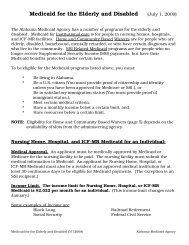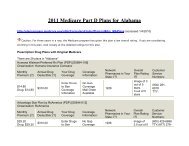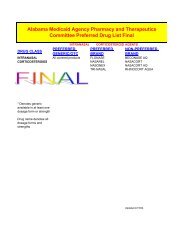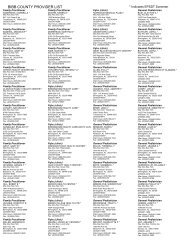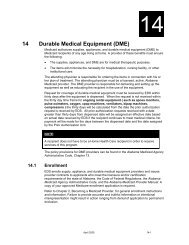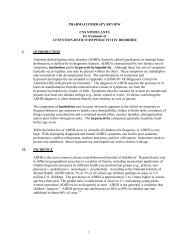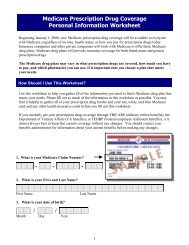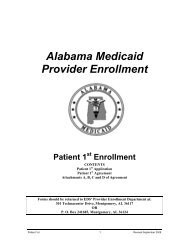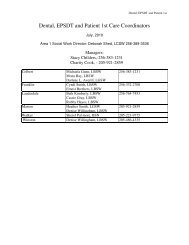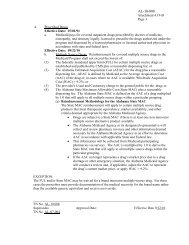Chronic Disease Self-Management Program (CDSMP)
Chronic Disease Self-Management Program (CDSMP)
Chronic Disease Self-Management Program (CDSMP)
You also want an ePaper? Increase the reach of your titles
YUMPU automatically turns print PDFs into web optimized ePapers that Google loves.
<strong>Chronic</strong> <strong>Disease</strong> <strong>Self</strong>-<strong>Management</strong> <strong>Program</strong> (<strong>CDSMP</strong>)<br />
Evidence-based <strong>Chronic</strong> <strong>Disease</strong> <strong>Self</strong>-<strong>Management</strong> <strong>Program</strong> for Older Adults<br />
<strong>Program</strong> Approved by AoA, CDC, and NCOA<br />
Contact Information<br />
Kate Lorig, Director<br />
Stanford Patient Education Research Center<br />
1000 Welch Road, Suite 204<br />
Palo Alto, CA 94304<br />
(650) 723-7935<br />
(650) 723-8165 (dedicated Spanish line)<br />
(650) 725-9422 fax<br />
self-management@stanford.edu<br />
http://patienteducation.stanford.edu/programs/cdsmp.html<br />
Year <strong>Program</strong> First Implemented in Community Settings: Early 1990s<br />
<strong>Program</strong> Synopsis<br />
• General description of program<br />
o <strong>CDSMP</strong> is a lay-led participant education program offered in communities<br />
in the United States and several other countries. Participants are adults<br />
experiencing chronic health conditions such as hypertension, arthritis,<br />
heart disease, stroke, lung disease, and diabetes; their family members,<br />
friends and caregivers can also participate. The program provides<br />
information and teaches practical skills on managing chronic health<br />
problems. The <strong>CDSMP</strong> gives people the confidence and motivation they<br />
need to manage the challenges of living with a chronic health condition.<br />
• <strong>Program</strong> goal<br />
o The overall goal is to enable participants to build self-confidence to<br />
assume a major role maintaining their health and managing their chronic<br />
health conditions.<br />
• Reasoning behind the program design and elements<br />
o People with chronic conditions have similar concerns and problems;<br />
o People with chronic conditions must deal not only with their disease(s),<br />
but also with the impact on their lives and emotions;<br />
o Lay people with chronic conditions, when given a detailed leader's<br />
manual, can teach the <strong>CDSMP</strong> as effectively, if not more effectively, than<br />
health professionals (Lorig et al, 1999); and<br />
o TThe process or the way the <strong>CDSMP</strong> is taught is as important, if not more<br />
important, than the subject matter that is taught.<br />
• Target population<br />
o Adults with chronic diseases<br />
• Essential program components and activities<br />
o The <strong>CDSMP</strong> focuses on problems common to individuals suffering from<br />
chronic diseases. Coping strategies such as action planning and feedback,<br />
behavior modeling, problem-solving techniques, and decisionmaking are
applicable to all chronic diseases. Individuals are taught to control their<br />
symptoms through:<br />
• Relaxation techniques.<br />
• Changing their diets.<br />
• Managing sleep and fatigue.<br />
• Using medications correctly.<br />
• Exercise.<br />
• Communication with health providers.<br />
• Length/Timeframe of program<br />
o 2.5 hours per week over a 6 week period.<br />
• Recommended class size<br />
o 10-16 people<br />
• Desired outcomes<br />
o Increases in healthy behaviors (i.e., exercise and cognitive symptom<br />
management techniques, such as relaxation)<br />
o Positive changes in health status (less pain, fatigue, and worry; less health<br />
distress)<br />
o Increased self-efficacy<br />
o Better communications with health providers<br />
o Fewer visits to physicians and emergency rooms<br />
• Measures and evaluation activities<br />
o The program should be monitored by a Master Trainer to ensure that it is<br />
being implemented according to the curriculum. <strong>Program</strong> leaders must<br />
also confirm that incoming program participants actually have a chronic<br />
disease. There are some outcome evaluation tools available that range<br />
from detailed (many questions covering various outcomes) to simple<br />
(whether and how successfully participants are following their action<br />
plans).<br />
Health Outcomes and Evidence Supporting Health Outcomes<br />
Over a period of 2 years, Agency for Healthcare Research and Quality (AHRQ)-funded<br />
investigators compared health behaviors, health status, and health services use in patients<br />
age 40 to 90 years (average age, 65) who had completed the <strong>CDSMP</strong> (Lorig et al., 1999).<br />
When compared to baseline measures taken for the 6 months prior to the <strong>CDSMP</strong>,<br />
researchers found that <strong>CDSMP</strong> participants had:<br />
• Increased exercise.<br />
• Better coping strategies and symptom management.<br />
• Better communication with their physicians.<br />
• Improvement in their self-rated health, disability, social and role activities, and<br />
health distress.<br />
• More energy and less fatigue.<br />
• Decreased disability.<br />
• Fewer physician visits and hospitalizations.<br />
2
Lorig et al. (2001a) found that after 1 year, <strong>CDSMP</strong> participants had:<br />
• Significant improvements in energy, health status, social and role activities, and<br />
self-efficacy.<br />
• Less fatigue or health distress.<br />
• Fewer visits to the emergency room.<br />
• No decline in activity or role functions, even though there was a slight increase in<br />
disability after 1 year.<br />
In the same study by Lorig et al. (2001a), after 2 years <strong>CDSMP</strong> participants had:<br />
• No further increase in disability.<br />
• Reduced health distress.<br />
• Fewer visits to physicians and emergency rooms.<br />
• Increased self-efficacy.<br />
The increase in patients' perceptions of their self-efficacy was associated with reduced<br />
health care use (Lorig et al., 2001a). <strong>Self</strong>-efficacy, the degree of belief people have that<br />
they can perform the behavior required to produce a desired outcome, is crucial to the<br />
success of the <strong>CDSMP</strong> (Lorig et al., 1999). The more self-efficacy people have, the more<br />
control they believe they have over their behavior (Lorig et al., 1999; Lorig, Mazonson,<br />
& Holman, 1992). Therefore, increasing self-efficacy contributes to better<br />
decisionmaking processes, stronger motivation, and perseverance (Lorig et al., 1992).<br />
<strong>Program</strong> Costs<br />
(For additional cost information, please see Stanford Patient Education website at<br />
http://patienteducation.stanford.edu/licensing/fees.html)<br />
• Training fees<br />
o $1,500 per health professional<br />
$800 for a lay person with chronic disease<br />
for the 4½ day <strong>CDSMP</strong> Master Training. Included in this training is all<br />
instruction, one set of all materials, and breakfast for 5 days, lunch for 4<br />
days and one evening banquet.<br />
o <strong>CDSMP</strong> books (~$19 each) and relaxation tapes/CDs (~$12 each) are<br />
required for each <strong>CDSMP</strong> class participant.<br />
Training given by Stanford at a site other than Stanford for <strong>CDSMP</strong> is $15,000 for 4 days<br />
(for Leaders' training) or 4½ days of training (for Master training).<br />
Every organization offering a Stanford program must have a license for that program. If<br />
more than one program is being offered, the organization must have a license for each<br />
program offered.<br />
Each license if good for 3 years from the date of issue. After each three year interval,<br />
licenses must be renewed.<br />
3
Every licensed organization must make a yearly report (due on the anniversary of original<br />
license agreement) to Stanford stating the number of workshops and number of<br />
participants offered during the past year, number of leader trainings conducted, and the<br />
names of all leaders trained with contact information.<br />
• Licenses for organizations receiving training from Stanford will be discounted by<br />
$250 dollars. Each organization can apply only one discount per program.<br />
• Licenses for organizations not receiving training from Stanford will be at the<br />
following rates:<br />
o $500.00 for offering 10 or fewer workshops a year<br />
o $800 for offering 20 or fewer workshops a year<br />
o $1,000 for offering 30 or fewer workshop a year<br />
o If an organization is offering more than 30 workshops a year, it must<br />
negotiate a license with Stanford’s Office of Technology Licensing<br />
<strong>Program</strong> Savings<br />
The <strong>CDSMP</strong> saved from $390 to $520 per patient over a 2-year study period because<br />
participants used fewer health care services. <strong>CDSMP</strong> participants used less hospital and<br />
physician services than they had used before participating in the program, and less than<br />
those who had not participated in the <strong>CDSMP</strong> control group (Lorig et al., 1999; Lorig et<br />
al., 2001a).<br />
Specifically, researchers found that hospitalization rates for <strong>CDSMP</strong> participants did not<br />
increase over the 2-year duration of the study. For example, during the first 6 months,<br />
<strong>CDSMP</strong> participants were hospitalized fewer days than they had been during the 6<br />
months before they began the program. (Lorig et al., 2001a). <strong>CDSMP</strong> participants also<br />
had 2.5 fewer visits to the emergency room and their physicians (Lorig et al., 2001a).<br />
The <strong>CDSMP</strong> cost between $70 and $200 per person to administer. After subtracting costs<br />
from the savings due to lower health services use, the total amount saved as a result of the<br />
<strong>CDSMP</strong> over a 2-year period was estimated at $390 to $520 per person (Lorig et al.,<br />
1999; Lorig et al., 2001a).<br />
Further evidence of the effectiveness of the <strong>CDSMP</strong> can be found in a study funded by<br />
Kaiser Permanente (Lorig, Sobel, Ritter, Laurent, & Hobbs, 2001b). Kaiser <strong>CDSMP</strong><br />
participants had fewer visits to the emergency room and fewer hospital days compared to<br />
the year prior to completing the <strong>CDSMP</strong>. As a result, they reduced their health care costs.<br />
(2001b).<br />
Kaiser Permanente paid approximately $200 per participant for <strong>CDSMP</strong> training,<br />
materials, and administration. With 489 participants, Kaiser's total cost was $97,800.<br />
However, if the cost to care for each participant decreased $990 because participants used<br />
fewer health services, Kaiser Permanente's net savings would be nearly $400,000 (Lorig,<br />
Sobel, Ritter, Laurent, & Hobbs, 2001b).<br />
4
Resource Requirements<br />
• Workshops can be offered in community settings such as senior centers, churches<br />
and hospitals. A flipchart and markers are required for each class.<br />
Training Requirements<br />
• Instructor training<br />
o Facilitator trainings for representatives of health care organizations are 4½<br />
days and are held at Stanford University. It is strongly suggested that<br />
health professionals bring a lay person with chronic disease with them. All<br />
workshops and trainings are designed to be facilitated by 2 people. Each<br />
trainee receives a detailed leader's manual, and a copy of the workshop's<br />
textbook and audio CDs (if applicable). Those being trained as Master<br />
Trainers (trainers of leaders) will also receive a trainer's manual and a<br />
program implementation tool kit. Two Stanford trainers will train up to 26<br />
Leaders and/or Master Trainers at an organization’s. Local Master<br />
Trainers can then serve as organizations’ on-site trainers for the future.<br />
You can combine your training with other organizations in your area to<br />
reduce your costs, if you wish.<br />
• Instructor certification required?<br />
o Yes<br />
• Instructor qualifications<br />
o Instructors must be health professionals or lay leaders or with a chronic<br />
health problem. Instructors must be able to complete the <strong>CDSMP</strong><br />
training.<br />
• Number of instructors required per class<br />
o Two. Workshops are facilitated by a team of two trained leaders, pairing<br />
either a health professional with a lay leader who has a chronic disease or<br />
two lay leaders.<br />
5
References<br />
Cost Data:<br />
Stanford Patient Education Research Center, Stanford University School of Medicine,<br />
Department of Medicine. <strong>Chronic</strong> <strong>Disease</strong> <strong>Self</strong>-<strong>Management</strong> <strong>Program</strong> Web site:<br />
http://patienteducation.stanford.edu/<br />
Summarizations of Outcome Data:<br />
Preventing Disability in the Elderly With <strong>Chronic</strong> <strong>Disease</strong>. Research In Action, Issue 3.<br />
AHRQ Publication No. 02-0O18, April 2002. Agency for Healthcare Research and<br />
Quality, Rockville, MD. http://www.ahrq.gov/research/elderdis.htm<br />
Stanford Patient Education Research Center, Stanford University School of Medicine,<br />
Department of Medicine. <strong>Chronic</strong> <strong>Disease</strong> <strong>Self</strong>-<strong>Management</strong> <strong>Program</strong> Web site:<br />
http://patienteducation.stanford.edu/<br />
Original outcome data:<br />
Lorig K.R., Mazonson P.D., Holman H.R. (1992). Evidence suggesting that health<br />
education for self-management in patients with chronic arthritis has sustained health<br />
benefits while reducing health care costs. Arthritis Rheum, 36(4):439-46.<br />
Lorig K.R., Sobel D.S., Stewart A.L., Brown Jr. B.W., Ritter P.L., González V.M.,<br />
Laurent D.D., Holman H.R. (1999). Evidence suggesting that a chronic disease selfmanagement<br />
program can improve health status while reducing utilization and costs: A<br />
randomized trial. Medical Care, 37(1):5-14.<br />
Lorig K.R., Ritter P., Stewart A.L., Sobel D.S., Brown B.W., Bandura A., González<br />
V.M., Laurent D.D., Holman H.R. (2001a). <strong>Chronic</strong> <strong>Disease</strong> <strong>Self</strong>-<strong>Management</strong> <strong>Program</strong>:<br />
2-year health status and health care utilization outcomes. Medical Care, 39(11),1217-<br />
1223.<br />
Lorig K.R., Sobel D.S., Ritter P.L., Laurent D., Hobbs M. (2001b). Effect of a selfmanagement<br />
program on patients with chronic disease. Effective Clinical Practice,<br />
4(6),256-262.<br />
This program overview was prepared by Ellen Schneider, Assistant Director for<br />
Communications and <strong>Program</strong> Relations, UNC Institute on Aging. For further program<br />
information, please contact the program administrator listed on page 1. Available health<br />
outcomes, cost, and savings data presented when known. We extend our thanks to the<br />
NC Area Agency on Aging directors for their assistance in designing the format for this<br />
document.<br />
6




